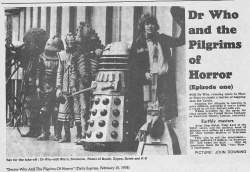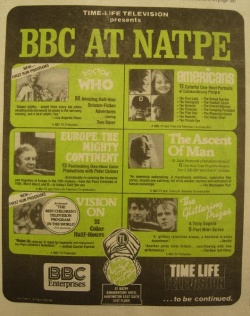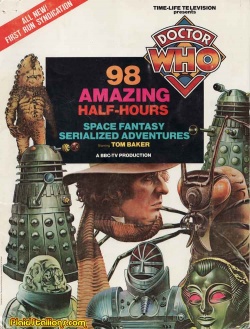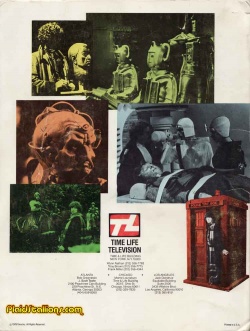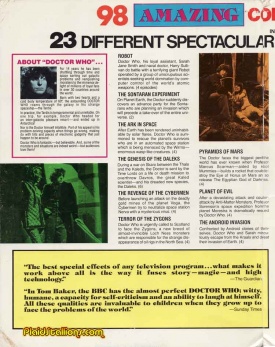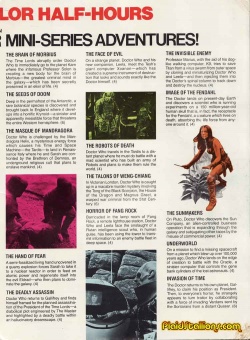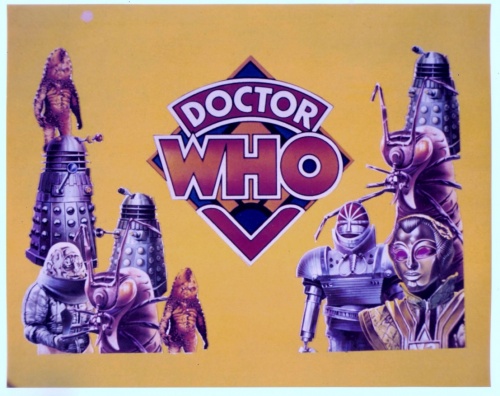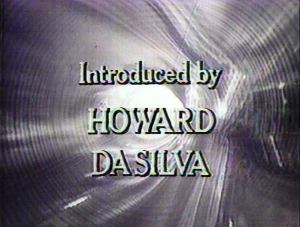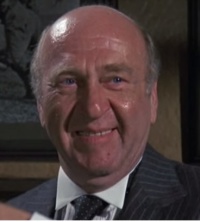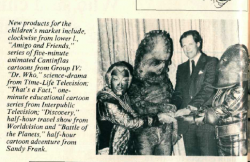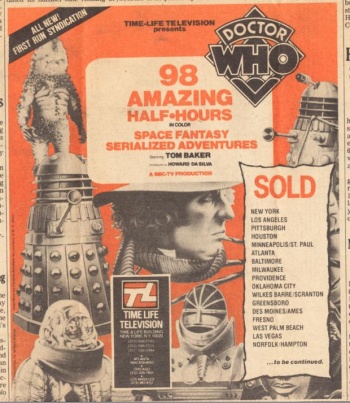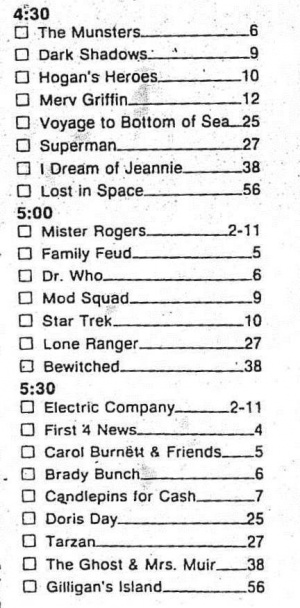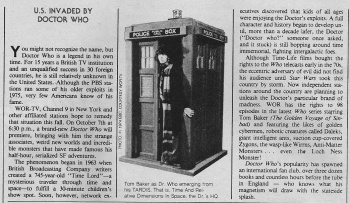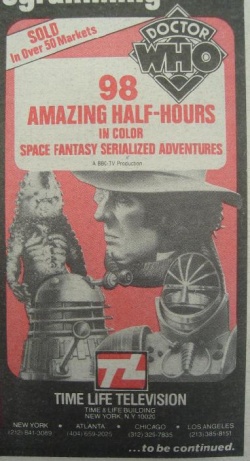United States--1978
From BroaDWcast
Revision as of 02:05, 28 October 2019 by John Lavalie (talk | contribs)
| United States Chronology | |
| 1963-1969 | 1971-1972 | 1973-1977 | 1978 | 1979 | 1980 | 1981 | 1982 | 1983 | 1984 | 1985 | 1986 | 1987 | 1988 | 1989 | 1990 | 1991-2020s | |
| Related articles | List of conventions | List of fan clubs | References to the USA in Doctor Who | Doctor Who USA Tour | USA Tour stops | Documentaries and specials | TV Guide | Saturday, March 12, 1988 | First airings by episode |United States by the numbers | Chicago chronology | Time-Life Television |
- January 1978: Following the success of Star Wars (which opened in Britain on 27 December 1977), and with the world hungry for science fiction entertainment featuring robots, space battles and monsters, the BBC decides to give their little SF series Doctor Who another shot at North America. By the end of the month, a deal is made with Time-Life Television (previously Time-Life Films, who sold the Jon Pertwee stories from 1972) to handle sales and distribution. NTSC tapes are made; at the time, the latest series (season 15) hadn't yet completed its run on UK television.
- 12 February 1978: Tom Baker with K9, and a collection of monsters (a Dalek, a Sontaran, a Zygon, a Wirrn, and a Voc robot) line up outside the American Embassy in Grosvenor Square, London, for a photo shoot to publicise the sale to the States.
- 15 February 1978: Variety magazine includes an ad from Time-Life listing some of the BBC programmes they will have on offer at the upcoming NATPE exhibit; included is a little something called Doctor Who. (The photo of the Cybermen has been cut from Target's Second Doctor Who Monster Book.)
- At the 4-8 March 1978, NATPE (National Association of Television Program Executives) exhibit, held at the Bonaventure Hotel in downtown Los Angeles, Time-Life Television promotes its latest syndication package of BBC programming, which includes Doctor Who. A lavish glossy sales brochure promoting the 98 AMAZING HALF HOURS is handed out to prospective buyers, which includes representatives from a number of PBS and network-affiliated stations across the US, as well as broadcasters in Ecuador, Venezuela, Mexico and Chile...
- The brochure features artwork by Chris Achilleos. Use of this (taken from Target's Second Doctor Who Monster Book) was not authorised by Achilleos, who received no payment for it, and was why Achilleos withdrew from painting any more covers for the Target novels.
| Time-Life brochure, 1978 | |
|---|---|
TOM BAKER
23 stories, 98 episodes:
| 4A | Robot | 4 |
| 4B | The Sontaran Experiment | 2 |
| 4C | The Ark in Space | 4 |
| 4D | Revenge of the Cybermen | 4 |
| 4E | Genesis of the Daleks | 6 |
| 4F | Terror of the Zygons | 4 |
| 4G | Pyramids of Mars | 4 |
| 4H | Planet of Evil | 4 |
| 4J | The Android Invasion | 4 |
| 4K | The Brain of Morbius | 4 |
| 4L | The Seeds of Doom | 6 |
| 4M | The Masque of Mandragora | 4 |
| 4N | The Hand of Fear | 4 |
| 4P | The Deadly Assassin | 4 |
| 4Q | The Face of Evil | 4 |
| 4R | The Robots of Death | 4 |
| 4S | The Talons of Weng-Chiang | 6 |
| 4V | Horror of Fang Rock | 4 |
| 4T | The Invisible Enemy | 4 |
| 4X | Image of the Fendahl | 4 |
| 4W | The Sun Makers | 4 |
| 4Y | Underworld | 4 |
| 4Z | The Invasion of Time | 6 |
- The episodes are edited slightly to bring them under 23 minutes (for instance the sequence with the Doctor trying on various outlandish costumes was removed from part one of Robot), and have narration voiced by actor Howard da Silva.
-The closing credits had a new "Introduced by HOWARD DA SILVA" caption added to them after the final "Directed by" caption.
-The lead character was referred to as "Doctor Who" in these narrations.
- The tape of part one of The Brain of Morbius is missing sound effects and music cues.
- Many stations screen the first eight stories out of order, usually based on BBC production codes, as listed above.
- Space Wars magazine (Vol 2/4, cover dated August 1978) carries the feature "Dr Who comes to America", but this focuses mainly on the Pertwee stories that were still airing in some States (with an episode guide, listing the 13 serials in alphabetical order) and does not mention the syndication of the Tom Baker series at all (see United States--1979 page for the magazine cover).
- Circa June 1978: The Hand of Fear airs as an omnibus "movie' as a preview story to "test" the series' potential in the US. It is known to have aired on WPTV, in West Palm Beach, Florida (and possibly a few months earlier New York station WOR, however no listings for it have been found).
- Industry publications, such as Broadcasting Magazine (12 June 1978 issue), and Variety (14 June 1978 issue), run Time-Life's full or half page ads for Doctor Who's "98 Amazing Half-Hours...".
- By August 1978, screenings of the Jon Pertwee stories draw to an end... Only 16 terrestrial stations across the United States (as well as US territory Guam) have aired the Pertwee episodes between 1972 and 1978. The final US station to purchase and air the full package of 13 Jon Pertwee stories is KDIN in Iowa, however the Qube cable screenings of a smaller selection of stories continues to play until the end of January 1979...
- 14 August 1978: Doctor Who is advertised in Television/Radio Age- see clipping below.
- 16 August 1978: Variety Magazine features Doctor Who on its cover again, this time a half-page ad which names the 17 cities to which the new Tom Baker series has so far been SOLD:
- 28 AUGUST 1978: The Tom Baker stories DEBUT on American television - at 5:00pm on channel 6, WTEV in Rhode Island which also served New Bedford, Massachusetts.
- September 1978: Starlog magazine (issue 18, cover dated October) reports that Doctor Who is now in syndication, and mentions it is due to start on WOR in New York, from 8 October.
- 11 October 1978: That week's issue of Variety magazine announces that Doctor Who had been "sold in over 50 markets" - see image below.
- 25 October 1978: Variety magazine carries a small review of the "low-budget sci-fi spoof", noting that was screening on WOR-TV in New York.
- As the fall television season gets under way, as many as 75 stations across America screen the "All New" series...
- According to an unnamed, undated American publication (but reported on page 182 of The Key To Time; Peter Haining; W H Allen; 1984), many of the initial of group stations drop the series due to poor ratings (which is certainly true of WVEC in Virginia). But others continue to pick it up, and within a year the programme is regularly being broadcast on 92 stations. Time-Life responds, saying that "Doctor Who's success in America is undeniable!"
| United States Chronology | |
| 1963-1969 | 1971-1972 | 1973-1977 | 1978 | 1979 | 1980 | 1981 | 1982 | 1983 | 1984 | 1985 | 1986 | 1987 | 1988 | 1989 | 1990 | 1991-2020s | |
| Related articles | List of conventions | List of fan clubs | References to the USA in Doctor Who | Doctor Who USA Tour | USA Tour stops | Documentaries and specials | TV Guide | Saturday, March 12, 1988 | First airings by episode |United States by the numbers | Chicago chronology | Time-Life Television |
